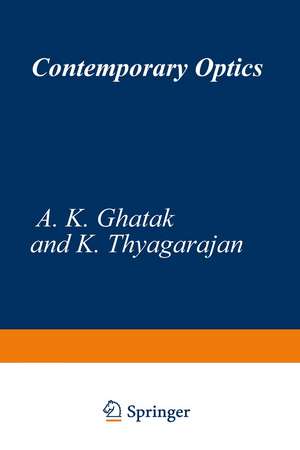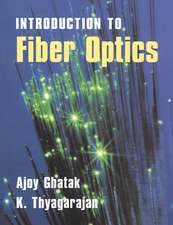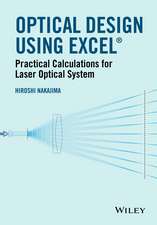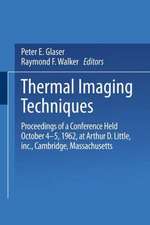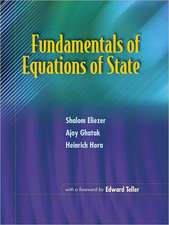Contemporary Optics: Optical Physics and Engineering
Autor A. Ghataken Limba Engleză Paperback – 12 dec 2012
Preț: 643.84 lei
Preț vechi: 757.46 lei
-15% Nou
Puncte Express: 966
Preț estimativ în valută:
123.19€ • 128.64$ • 101.73£
123.19€ • 128.64$ • 101.73£
Carte tipărită la comandă
Livrare economică 15-29 aprilie
Preluare comenzi: 021 569.72.76
Specificații
ISBN-13: 9781468423600
ISBN-10: 1468423606
Pagini: 384
Ilustrații: X, 370 p. 23 illus.
Dimensiuni: 152 x 229 x 20 mm
Greutate: 0.51 kg
Ediția:Softcover reprint of the original 1st ed. 1978
Editura: Springer Us
Colecția Springer
Seria Optical Physics and Engineering
Locul publicării:New York, NY, United States
ISBN-10: 1468423606
Pagini: 384
Ilustrații: X, 370 p. 23 illus.
Dimensiuni: 152 x 229 x 20 mm
Greutate: 0.51 kg
Ediția:Softcover reprint of the original 1st ed. 1978
Editura: Springer Us
Colecția Springer
Seria Optical Physics and Engineering
Locul publicării:New York, NY, United States
Public țintă
ResearchCuprins
1. Paraxial Ray Optics.- 1.1. Introduction.- 1.2. Fermat’s Principle.- 1.3. Lagrangian Formulation.- 1.4 Hamiltonian Formulation.- 1.5. Application of the Hamiltonian Formulation to the Study of Paraxial Lens Optics.- 1.6. Eikonal Approximation.- 1.7. Wave Optics as Quantized Geometrical Optics.- 2. Geometrical Theory of Third-Order Aberrations.- 2.1. Introduction.- 2.2. Expressions for Third-Order Aberrations.- 2.3. Physical Significance of the Coefficients A, B, C, D, and E.- 2.4. The Coefficients Hij in Terms of Refractive-Index Variation.- 2.5. Aberrations of Graded-Index Media.- 2.6. Aberrations in Systems Possessing Finite Discontinuities in Refractive Index.- 2.7. Chromatic Aberration.- 3. Characteristic Functions.- 3.1. Introduction.- 3.2. Point Characteristic function.- 3.3. Mixed Characteristic function.- 3.4. Angle Characteristic function.- 3.5. Explicit Evaluation of Characteristic Functions.- 4. Diffraction.- 4.1. Introduction.- 4.2. The Spherical Wave.- 4.3. Integral Theorem of Helmholtz and Kirchhoff.- 4.4. The Fresnel-Kirchhoff Diffraction Formula.- 4.5. Fraunhofer and Fresnel Diffraction.- 4.6. Fraunhofer Diffraction by a Rectangular Aperture.- 4.7. Fraunhofer Diffraction by a Circular Aperture.- 4.8. Distribution of Intensity in the Airy Pattern.- 4.9. Fresnel Diffraction by a Circular Aperture.- 4.10. Fresnel Diffraction by a Single Slit.- 4.11. Diffraction of Waves Having Amplitude Distribution along the Wavefront.- 4.12. Babinet’s Principle.- 4.13. Periodic Apertures.- 4.14. Intensity Distribution near the Focal Plane.- 4.15. Optical Resonators.- 5. Partially Coherent Light.- 5.1. Introduction.- 5.2. Complex Representation.- 5.3. Mutual Coherence Function and Degree of Coherence.- 5.4. Quasi-Monochromatic Sources.- 5.5. Van Cittert-ZernikeTheorem.- 5.6. Differential Equations Satisfied by ?12(?).- 5.7. Partial Polarization.- 6. Fourier Optics I. Spatial Frequency Filtering.- 6.1. Introduction.- 6.2. Fraunhofer and Fresnel Diffraction Approximations.- 6.3. Effect of a Thin Lens on an Incident Field Distribution.- 6.4. Lens as a Fourier-Transforming element.- 6.5. Spatial Frequency Filtering and Its Applications.- 7. Fourier Optics II. Optical Transfer Functions.- 7.1. Introduction.- 7.2. The Point-Spread function.- 7.3. Point-Spread Function of a Thin Lens.- 7.4. Frequency Analysis.- 7.5. Coherence and Resolution.- 8. Holography.- 8.1. Introduction.- 8.2. The Underlying Principle.- 8.3. Interference between Two Plane Waves.- 8.4. Point Source Holograms.- 8.5. Diffuse Illumination of the Object.- 8.6. Fourier Transform Holograms.- 8.7. Volume Holograms.- 8.8. Applications of Holography.- 9. Self-Focusing.- 9.1. Introduction.- 9.2. Elementary Theory of Self-Focusing.- 9.3. More Rigorous Theory for Self-Focusing.- 9.4. Thermal Self-Focusing/Defocusing of Laser Beams.- 9.5. Solution of the Scalar Wave Equation with Weak Nonlinearity.- 9.6. General Problems on the Calculation of the Nonlinear Dielectric Constant.- 10. Graded-Index Waveguides.- 10.1. Introduction.- 10.2. Modal Analysis.- 10.3. Propagation through a Selfoc Fiber.- 10.4. Pulse Propagation.- 10.5. Fabrication.- 11. Evanescent Waves and the Goos-Hänchen Effect.- 11.1. Introduction.- 11.2. Existence of Evanescent Waves.- 11.3. Total Internal Reflection of a Bounded Beam.- 11.4. Physical Understanding of the Goos-Hänchen Shift.- 11.5. The Goos-Hänchen Effect in a Planar Waveguide.- 11.6. Prism-Film Coupler.- Appendix A. The Dirac Delta Function.- B. The Fourier Transform.- C. Solution of Equation (10.2–12).- References.
